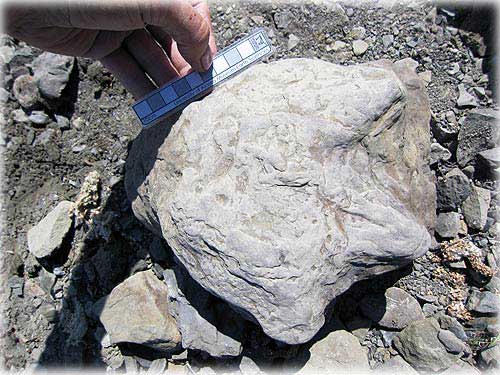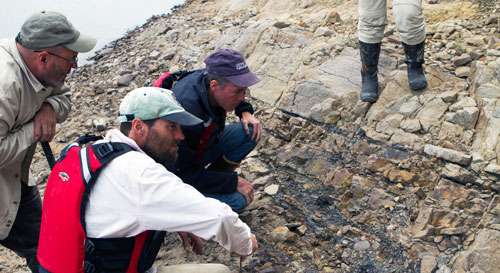
New dinosaur site discovered along Yukon RiverBy Theresa Bakker
September 23, 2013
A recent trip netted about 2,000 pounds of dinosaur footprints for the museum’s collection, according to earth sciences curator Pat Druckenmiller “There aren’t many places left in the world where paleontologists can just go out and find thousands of dinosaur footprints. This is the kind of discovery you would have expected in the Lower 48 a hundred years ago.” Hind foot print of an herbivorous dinosaur.
They found much more than they expected: dinosaur footprints big and small, from both meat- and plant-eaters. “We found a great diversity of dinosaur types,” Druckenmiller said, “evidence of an extinct ecosystem we never knew existed.” Paul McCarthy, Druckenmiller’s colleague from the Department of Geology and Geophysics at the University of Alaska Fairbanks, says the trip was amazing. “We found dinosaur footprints by the scores on literally every outcrop we stopped at,” he said. “I’ve seen dinosaur footprints in Alaska now in rocks from southwest Alaska, the North Slope, and Denali National Park in the Interior, but there aren’t many places where footprints occur in such abundance.” McCarthy is a geologist whose major research interests include paleolandscape evolution. He says the dinosaur footprint-bearing rocks from along the Yukon River are probably about 25-30 million years older than what’s been found in Denali Park. “It took several years of dedicated looking before the first footprint was discovered in Denali in 2005, but since that time hundreds of tracks of dinosaurs and birds have been found. In contrast, the tracks were so abundant along the Yukon River that we could find and collect as many as 50 specimens in as little as 10 minutes.” Kevin May, Pat Druckenmiller and Paul McCarthy (left to right) inspecting an outcrop of Cretaceous rock along the Yukon River.
“These are not negative impressions,” he said. “Rather they stick out from the rock and sometimes look like blobs with toes.” The discovery is significant in that the Yukon River fossils are geologically older than other major sites in the state and that they preserve a record of dinosaurs previously unknown in the state. “We have a whole lot of work to do,” Druckenmiller said. “We look forward to returning to the area and studying the site more.” The museum is working with villages and Native corporations along the Yukon River to share information about the discovery with local communities and to coordinate future exploration. The research team also included Jørn Hurum, from the University of Oslo Natural History Museum, UAMN earth sciences collection manager Julie Rousseau, and several UAF students. Roger Topp, head of production at the museum, filmed the expedition for an exhibit the museum is planning for the summer of 2015.
E-mail your news &
photos to editor@sitnews.us
|
||

